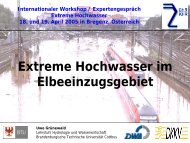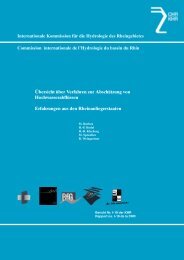ABSTRACTS 'Extreme Discharges' - CHR-KHR
ABSTRACTS 'Extreme Discharges' - CHR-KHR
ABSTRACTS 'Extreme Discharges' - CHR-KHR
You also want an ePaper? Increase the reach of your titles
YUMPU automatically turns print PDFs into web optimized ePapers that Google loves.
Transboundary effects of flooding and flood reducing measures along the Rhine in<br />
Northrhine-Westfalia (Germany) and Gelderland (the Netherlands)<br />
Rita Lammersen<br />
Institute of Inland water Management and waste water treatment (RWS-RIZA)<br />
P.O. Box 9072, NL 6800 ED Arnhem, the Netherlands<br />
r.lammersen@riza.rws.minvenw.nl<br />
Bernd Mehlig<br />
The Northrhine-Westfalia State Environment Agency (LUA)<br />
Wallneyer strasse 6, D-45133 Essen, Germany<br />
bernd.mehlig@lua.nrw.de<br />
1. Introduction<br />
After the big floods in 1993 and 1995, which took place in the river Rhine basin, the Province of Gelderland<br />
(The Netherlands), Rijkswaterstaat (The Netherlands) and the Ministry of Environment, Nature Conversation,<br />
Agriculture and Consumer Protection in Northrhine-Westfalia (Germany) signed a declaration for cooperation<br />
in flood control. As part of the cooperation, the project “Effects of extreme floods along the Niederrhein (Lower<br />
Rhine)” was carried out to investigate the effects of extreme floods along the Rhine in Northrhine-Westfalia<br />
(NRW) and in Gelderland. The aim of the project was to raise knowledge on the occurrence and behaviour of<br />
extreme floods in the Rhine catchment, to indicate areas vulnerable for flooding in NRW and Gelderland and to<br />
develop techniques and tools for the evaluation of flood reduction measures.<br />
2. Research Methods<br />
In order to reach the aim of the project “Effects of extreme floods along the Niederrhein (Lower Rhine)” research<br />
was carried out for the whole catchment area of the river Rhine followed by a more detailed investigation<br />
of the area of the Lower Rhine in Germany and the Dutch Rhine branches.<br />
A stochastic weather generator, developed by the Dutch Meteorological Institute (KNMI), was used to produce<br />
an artificial time series of 1000 year of precipitation and temperature (Buishand and Brandsma, 2001). The input<br />
consisted of 30 years of measured meteorological data of 34 different weather stations inside the Rhine<br />
catchment area. The generated time series, with the same statistics as the historical data, was then put into a<br />
rainfall-runoff model of the complete Rhine basin (HBV) and was transformed to discharge. A selection was<br />
made of the 16 most extreme events, based on the HBV results at Andernach and Lobith. These 16 extreme<br />
events were then put into a 1-dimensional flood routing model to compute the 16 highest discharge waves at<br />
Andernach in a more accurate way, taking into account flooding and retention measures along the Rhine upstream<br />
of Andernach (for more information see Eberle et al., 2004 and Lammersen, 2004).<br />
With the two most extreme discharge waves at Andernach flood simulations have been performed using the 2-<br />
dimensional model Delft-FLS. A Delft-FLS model was made of the Rhine downstream Rhine-km 642 (which is<br />
downstream of Andernach) using a 100 m X 100 m grid on top of a digital terrain model. In this model dikes<br />
and flood walls are modeled as grid cells. When the water level reaches the dike level a dike collapse occurs. In<br />
case of a flood wall, or a natural levee, the floodwall or levee simply overflows and no collapse is simulated.<br />
Two situations have been considered: the year 2002 and 2020, with the dike levels of 2002 and 2020 respectively.<br />
The input of the 2D-model consisted of the discharge at Andernach and the tributaries of the Rhine. The<br />
output consisted of information about locations of a dike collapse or an overflow, inflow to the protected area,<br />
flood patterns inside the protected area, effect on the discharge wave and finally the discharge capacity of the<br />
Rhine (for more information see Gudden, 2004, and Lammersen, 2004).<br />
The results of the 2D flood simulations were then transferred to a 1-dimensional SOBEK-model. Each dike<br />
collapse or overflow was modeled as a retention basin. Parameters like surface area, capacity, inflow and outflow<br />
were based on information from the Delft-FLS model (for more information see van der Veen et al., 2004a<br />
and Lammersen, 2004).<br />
61





